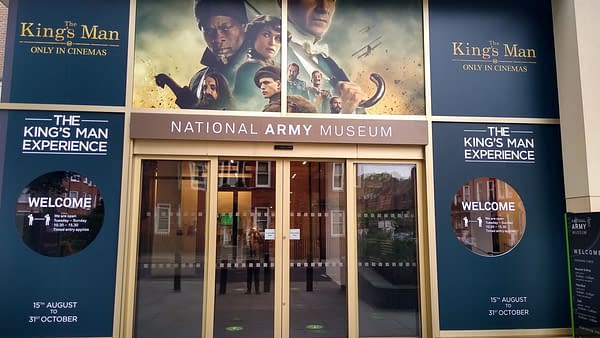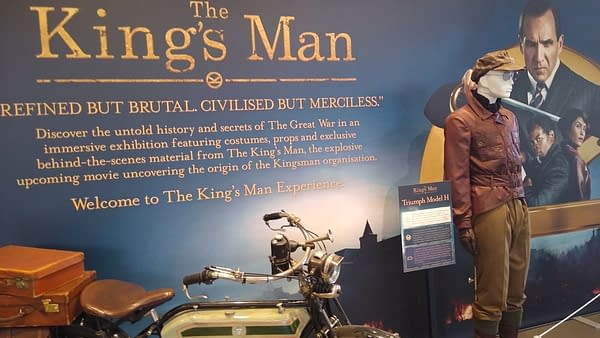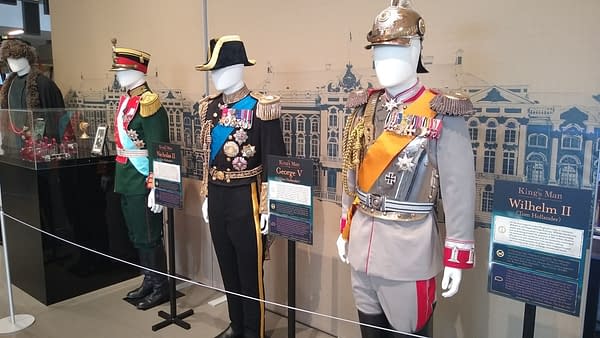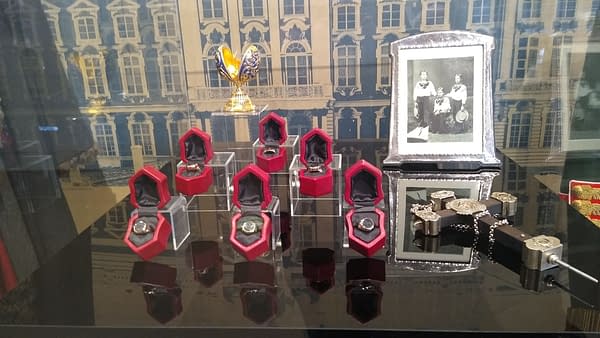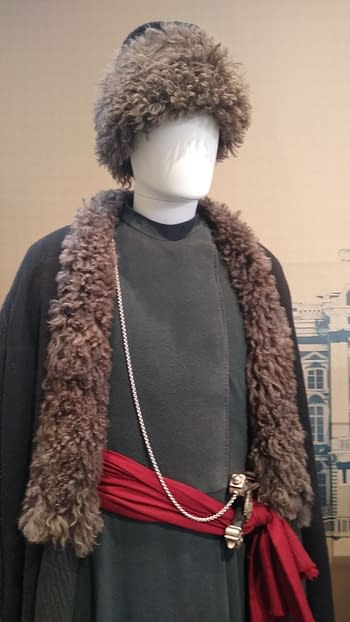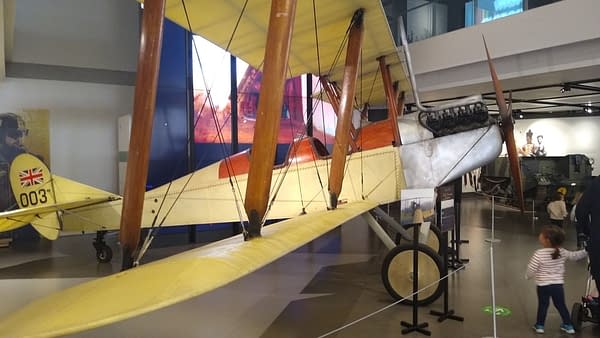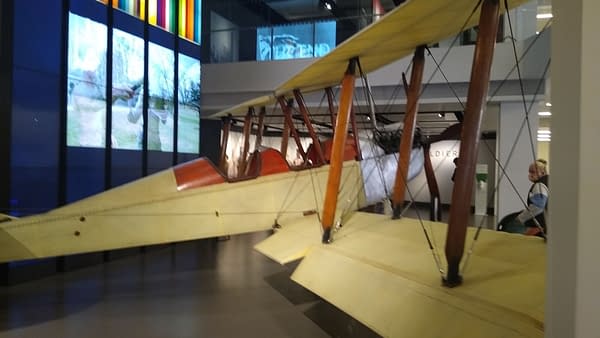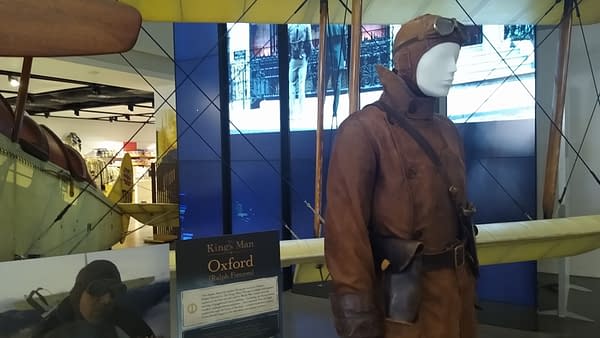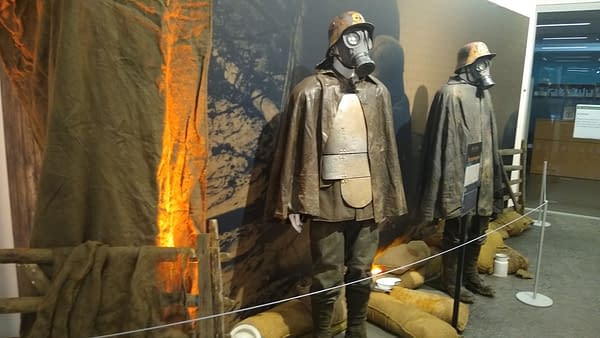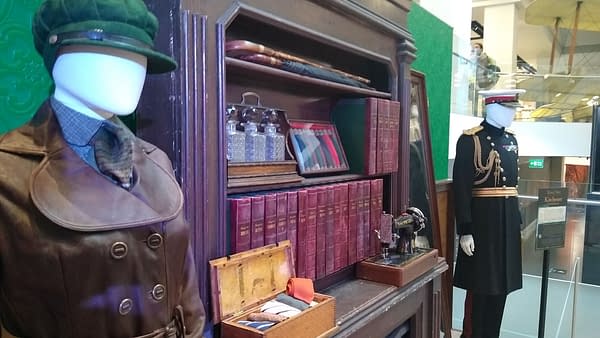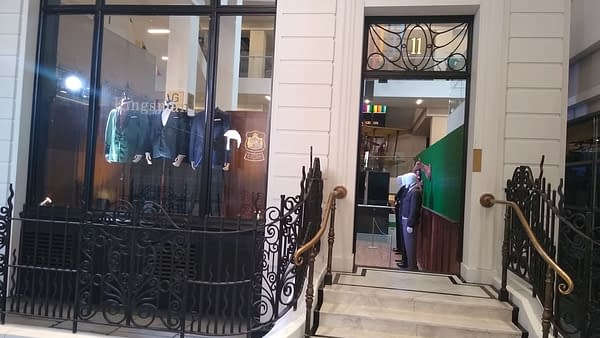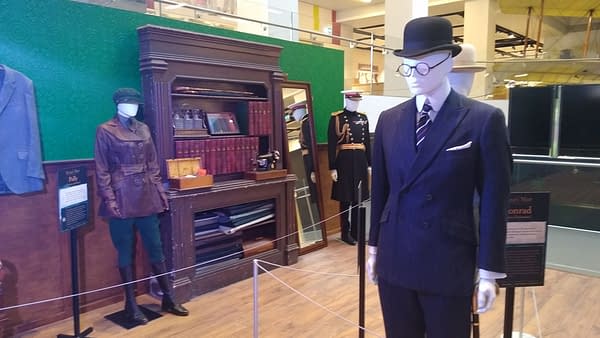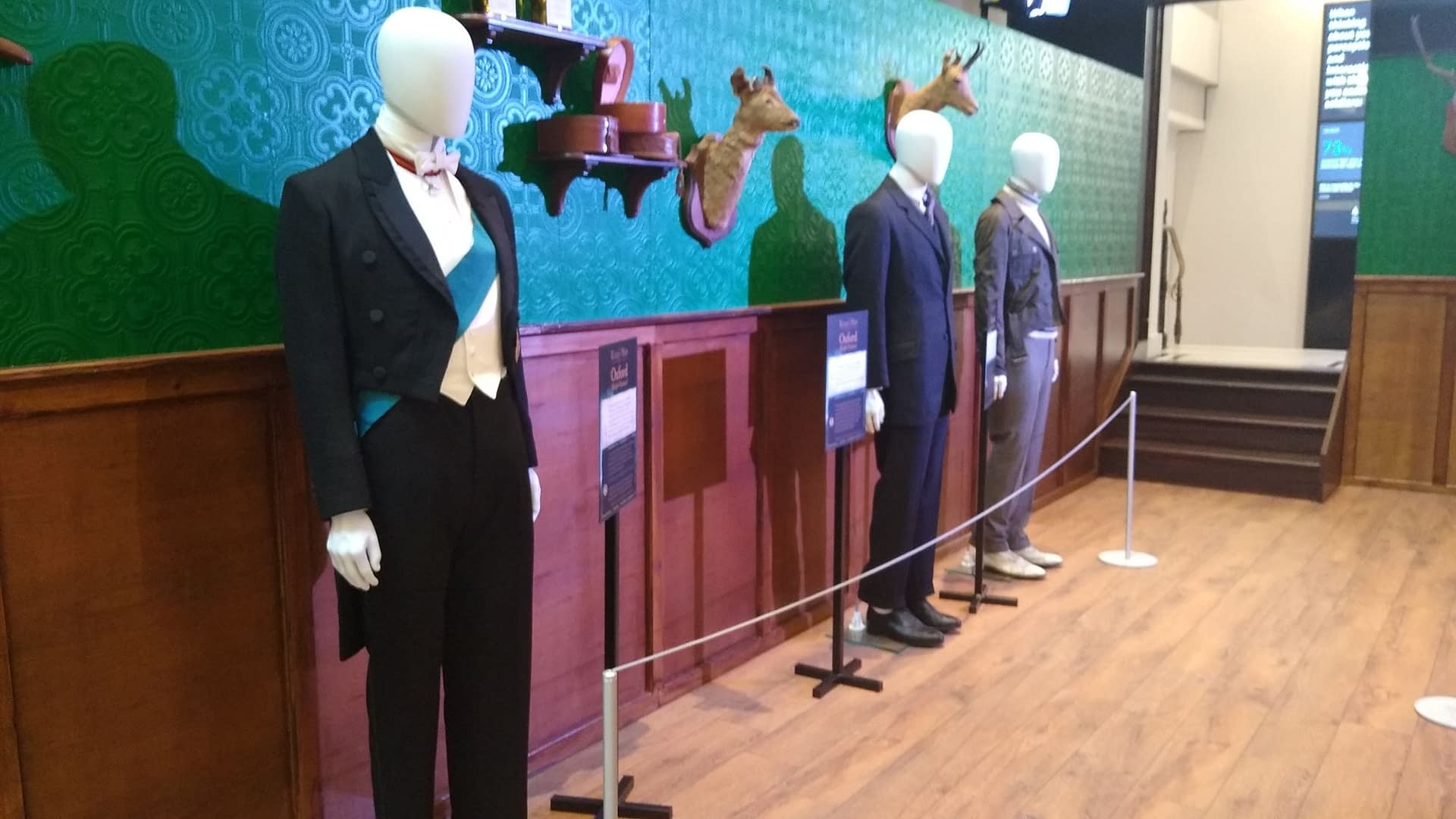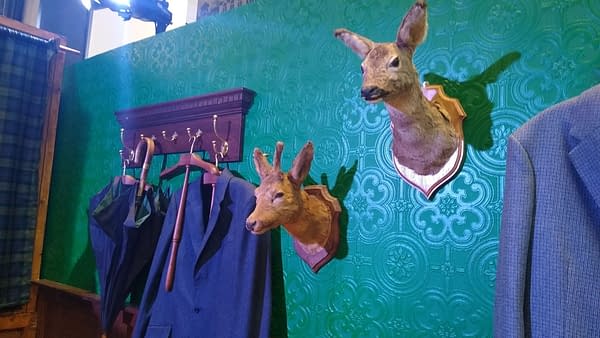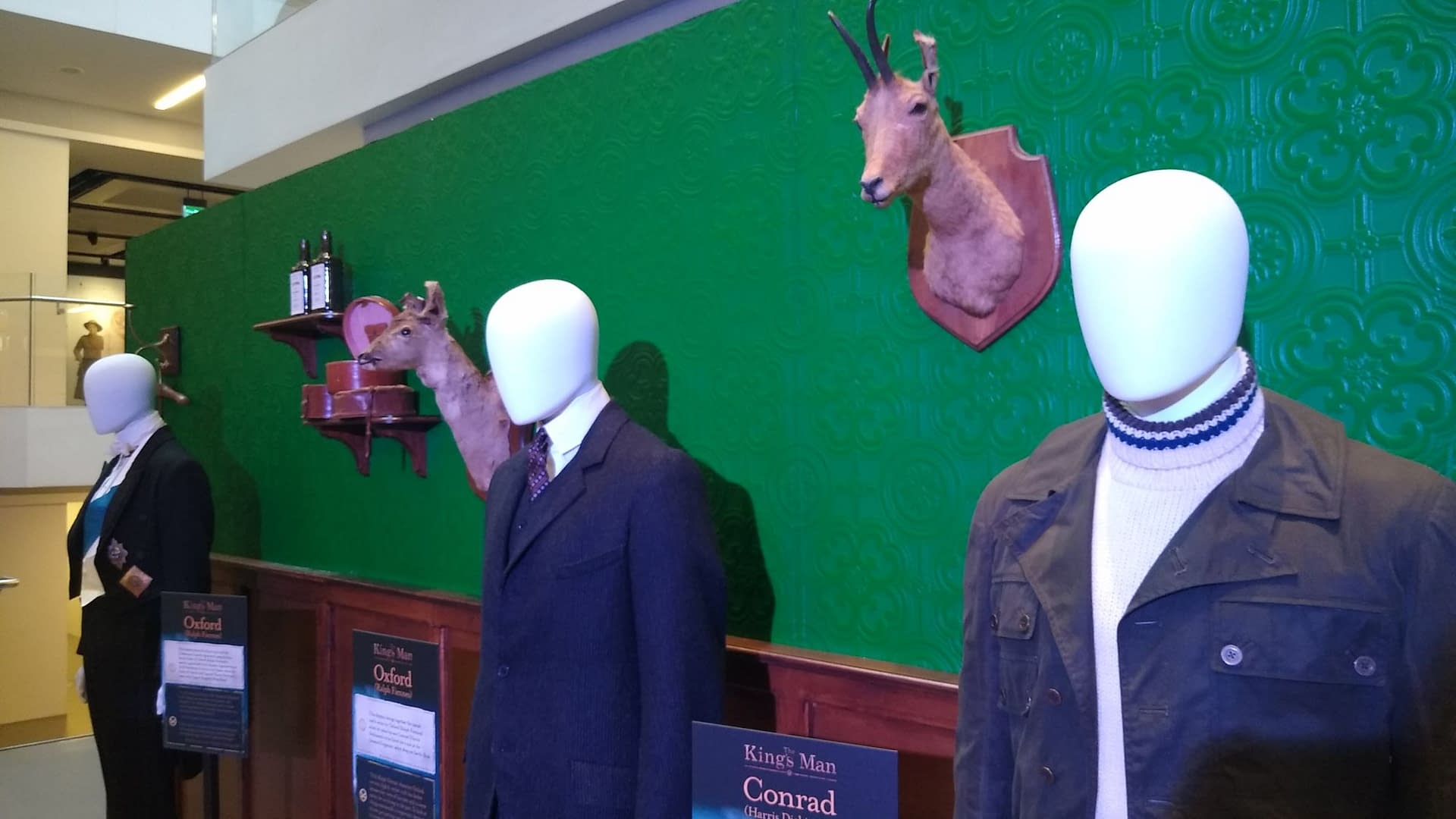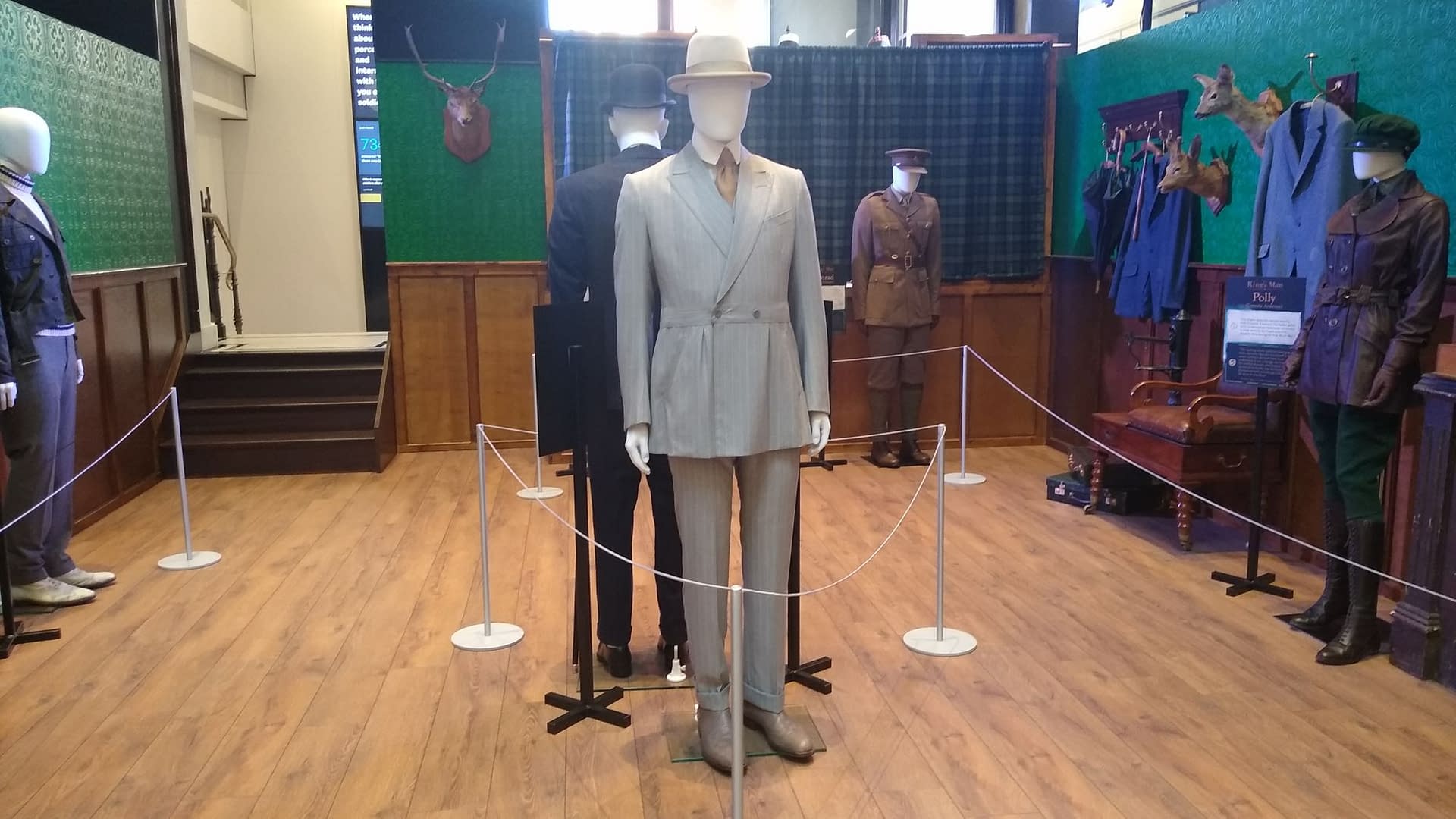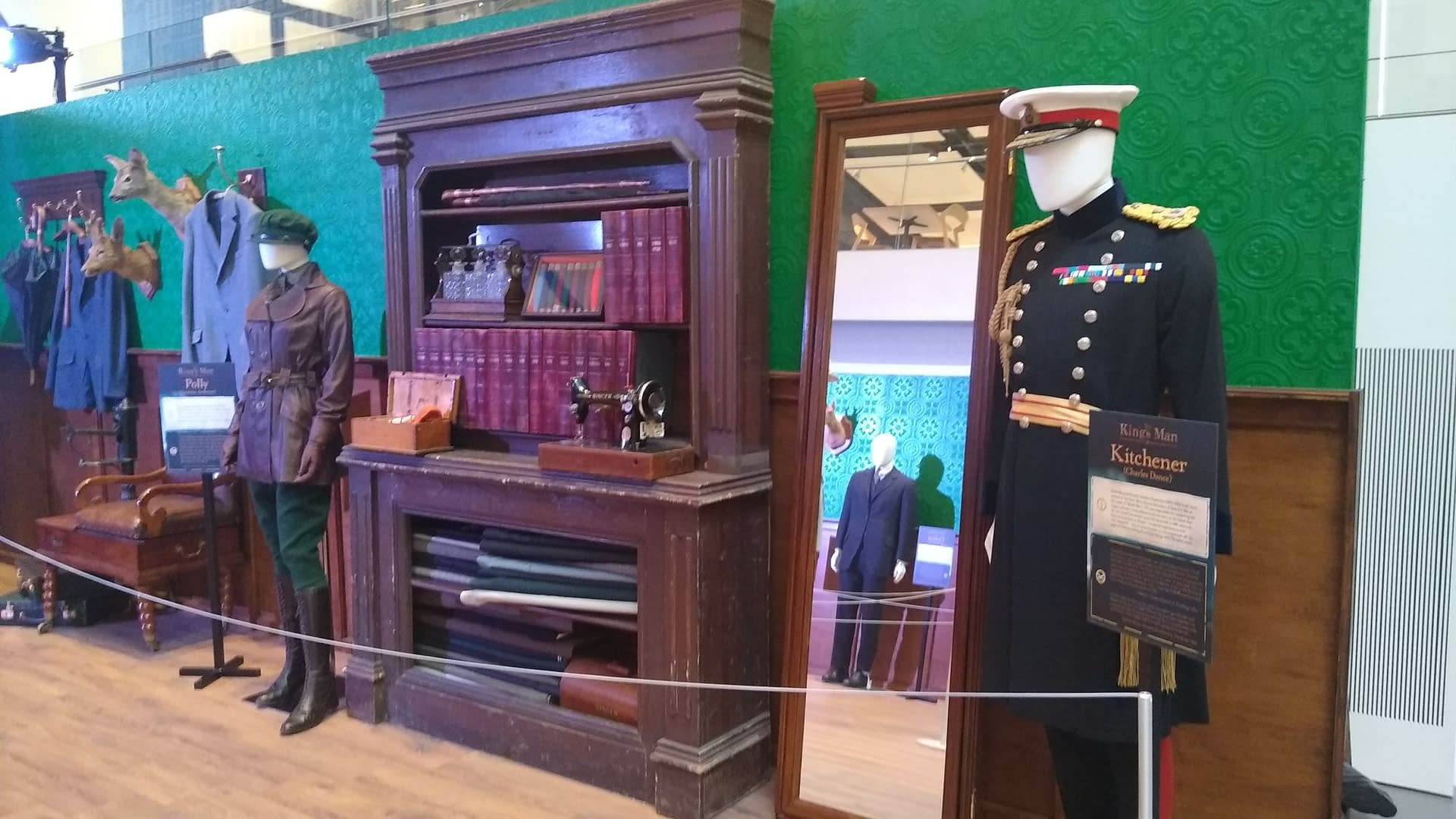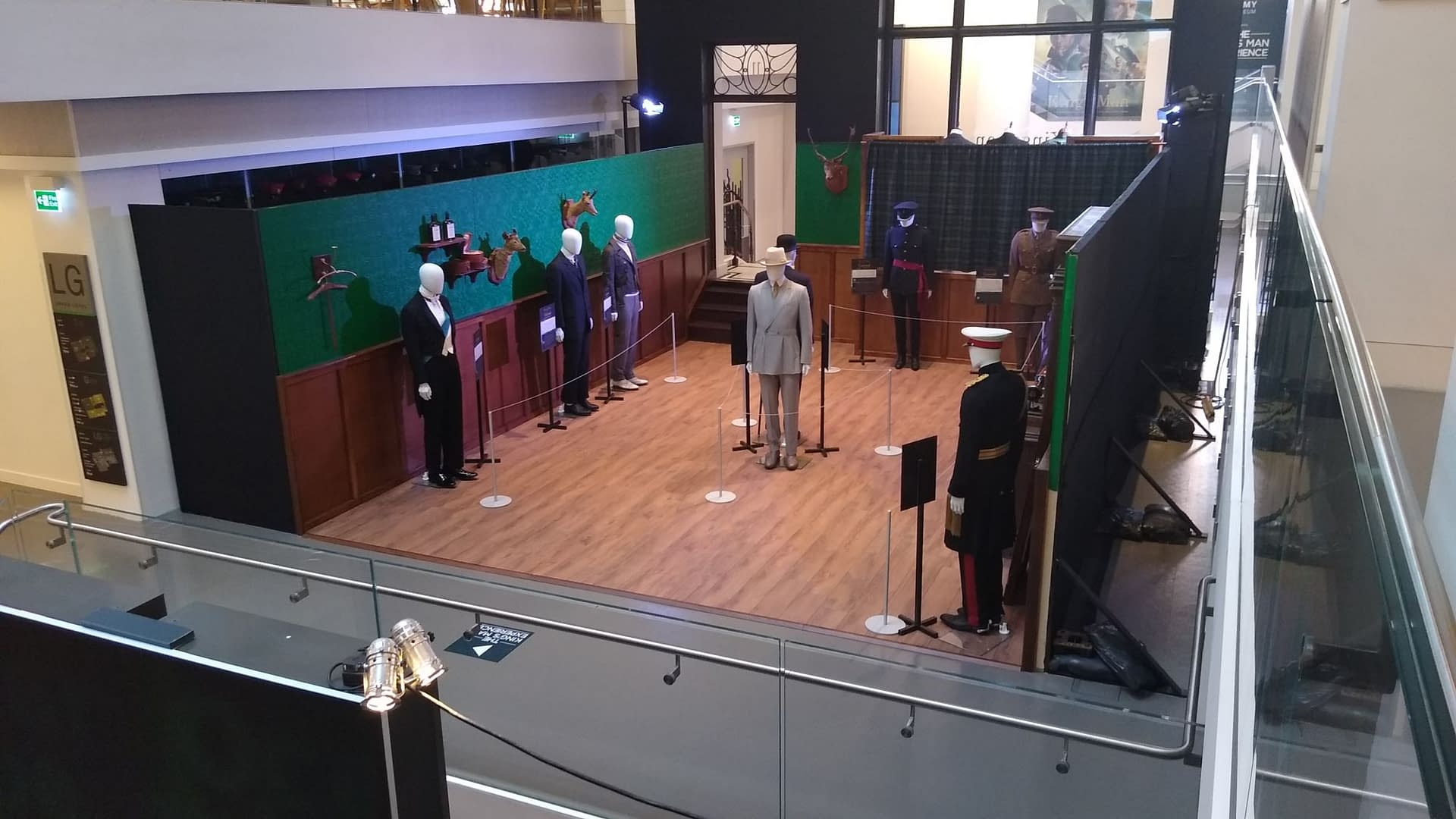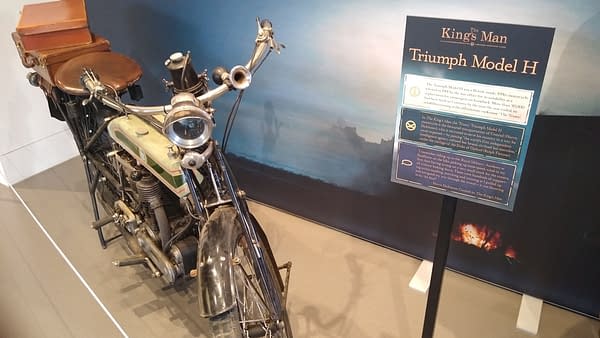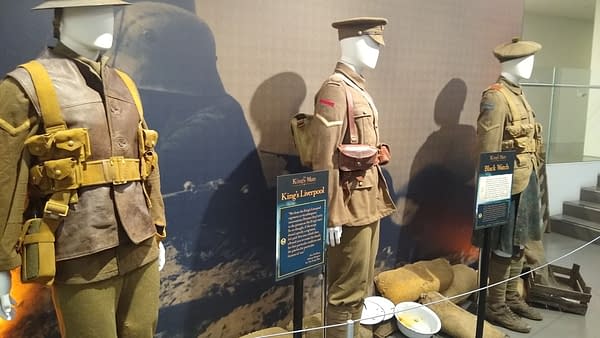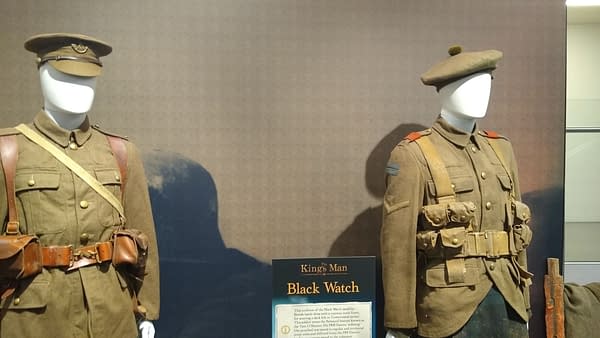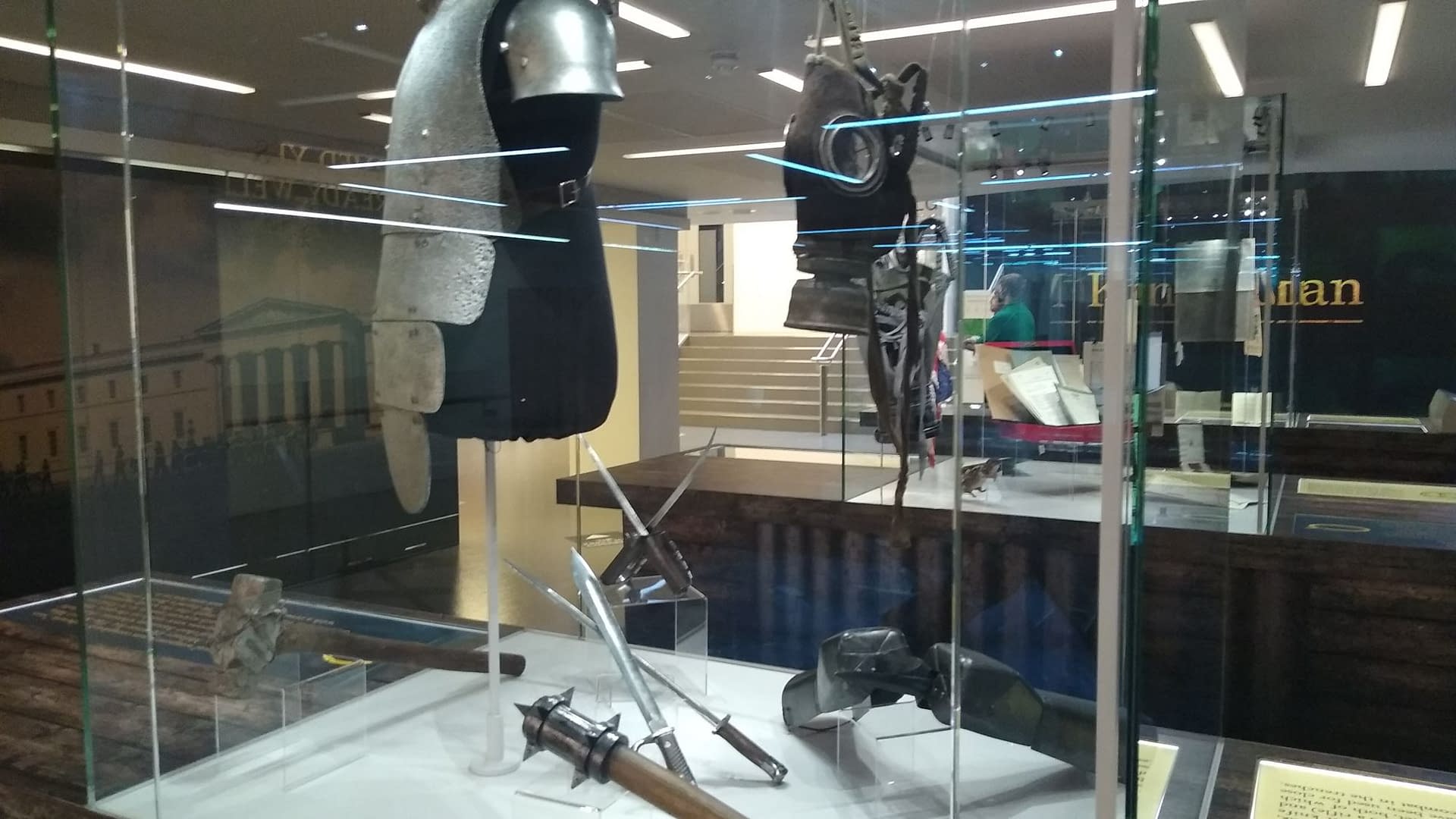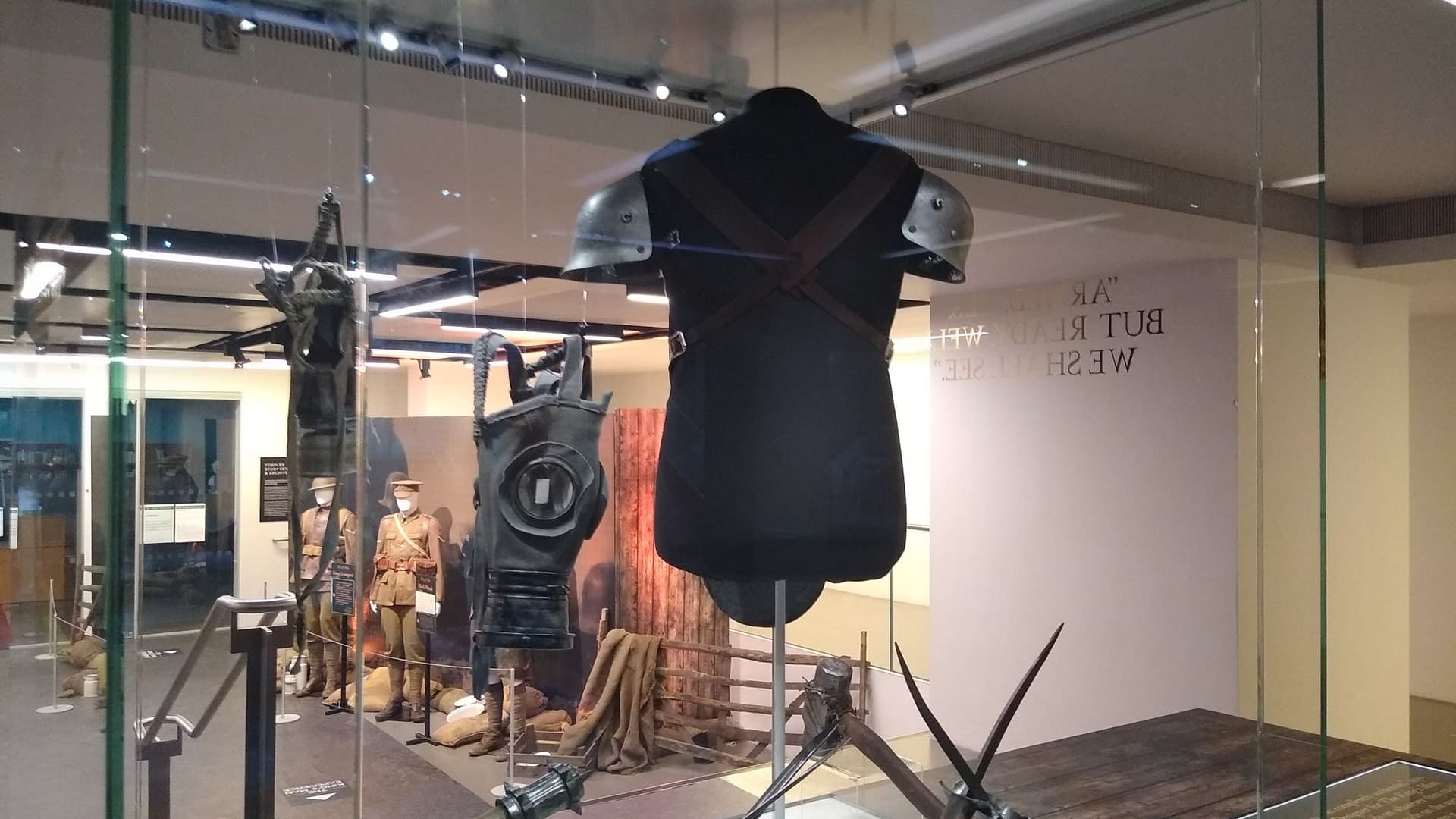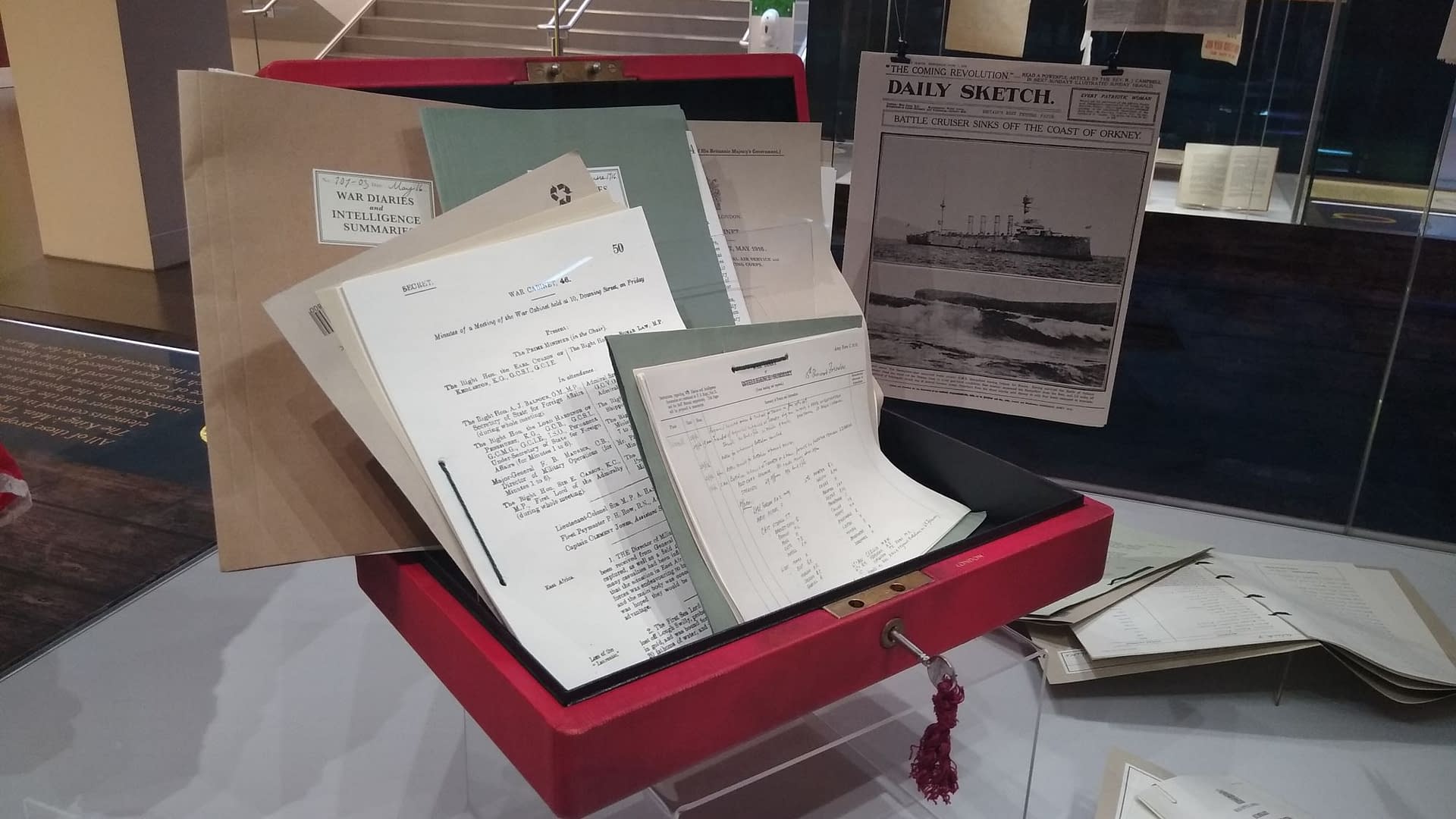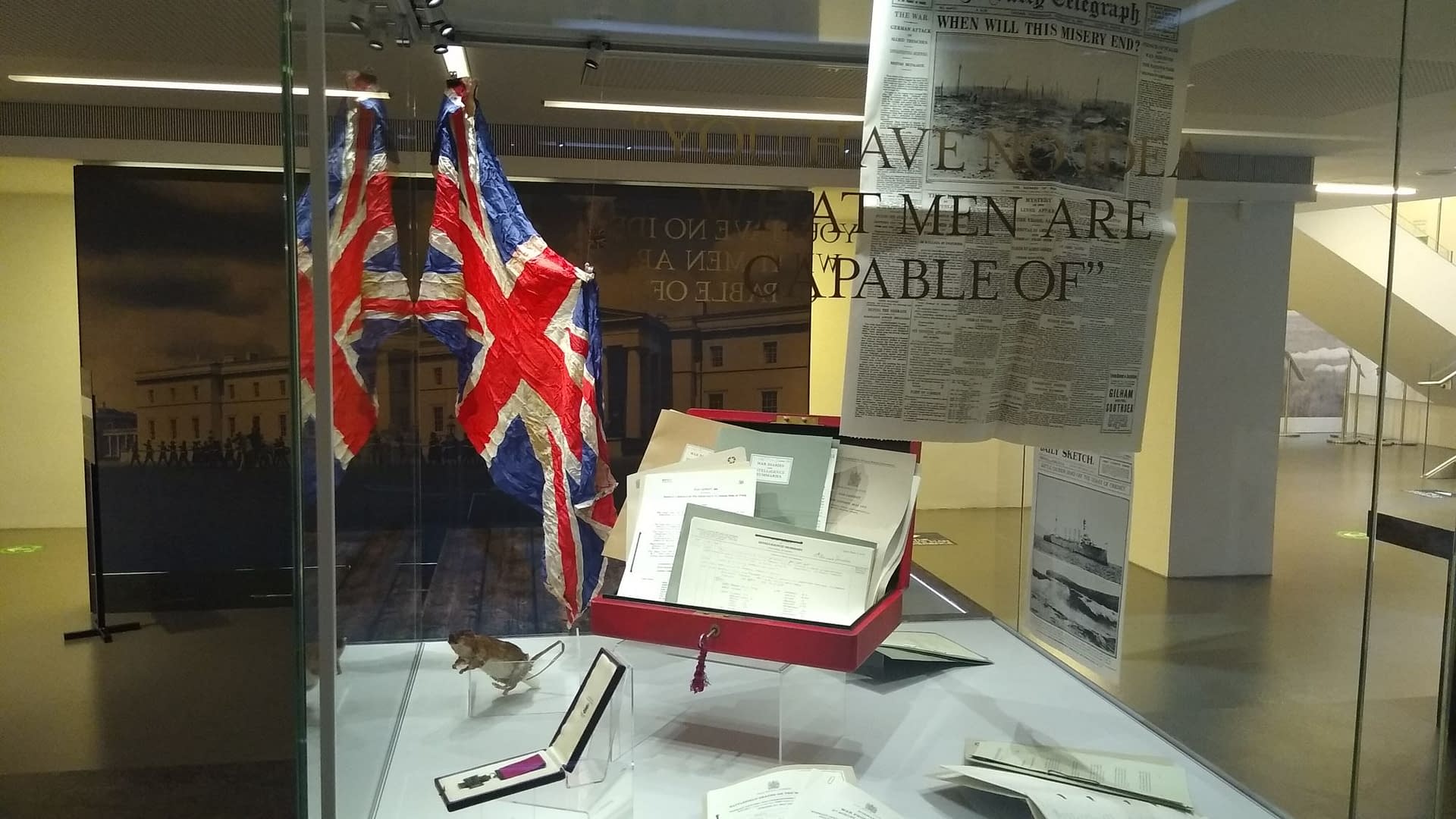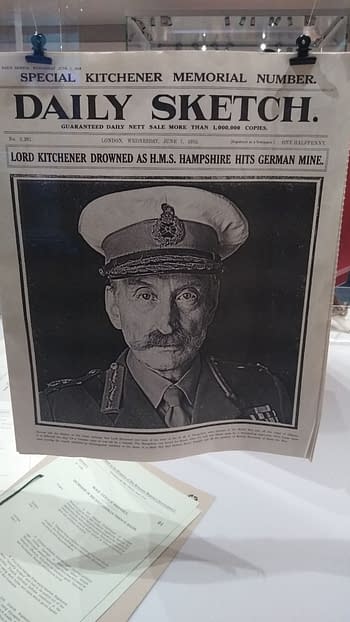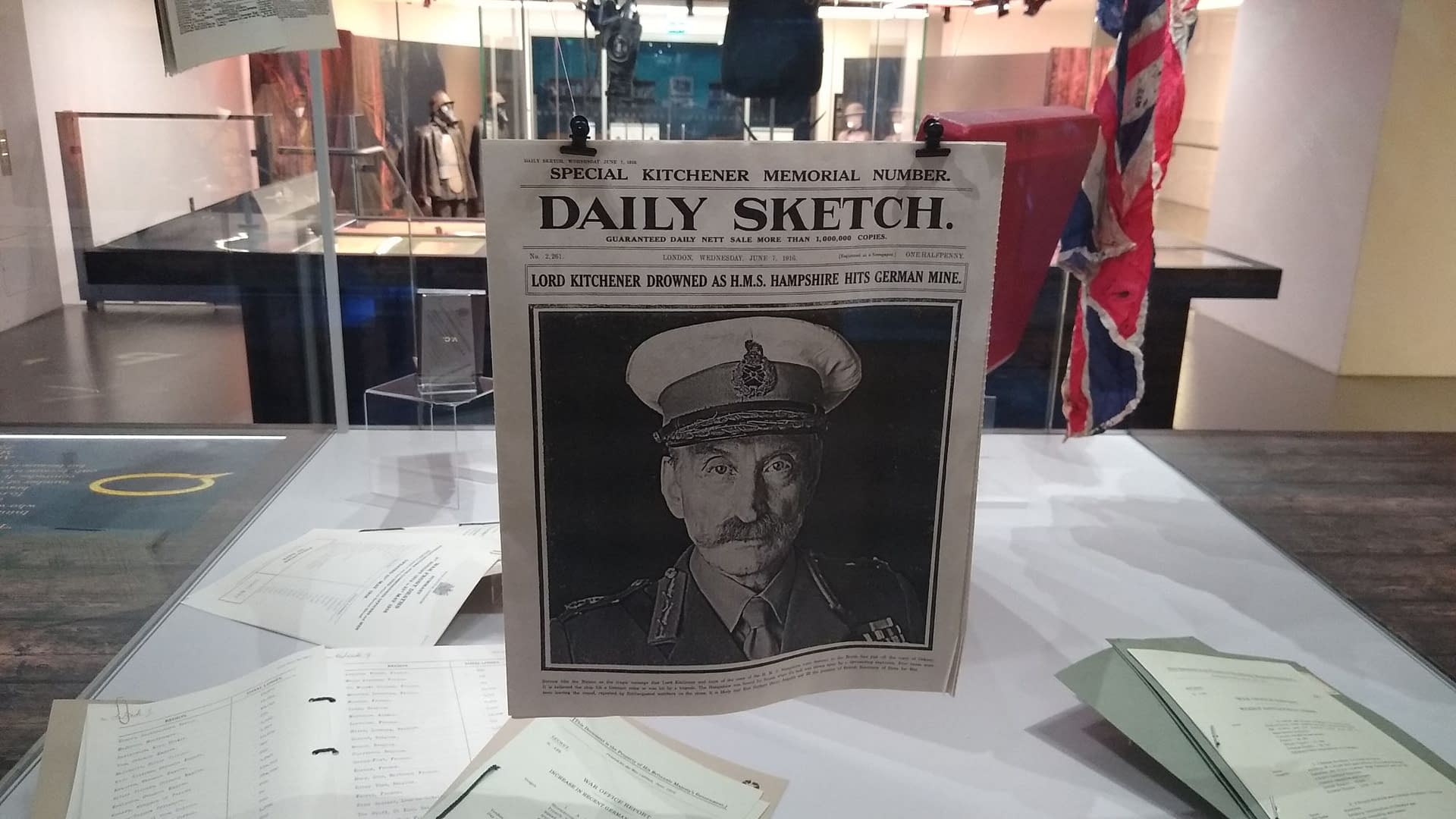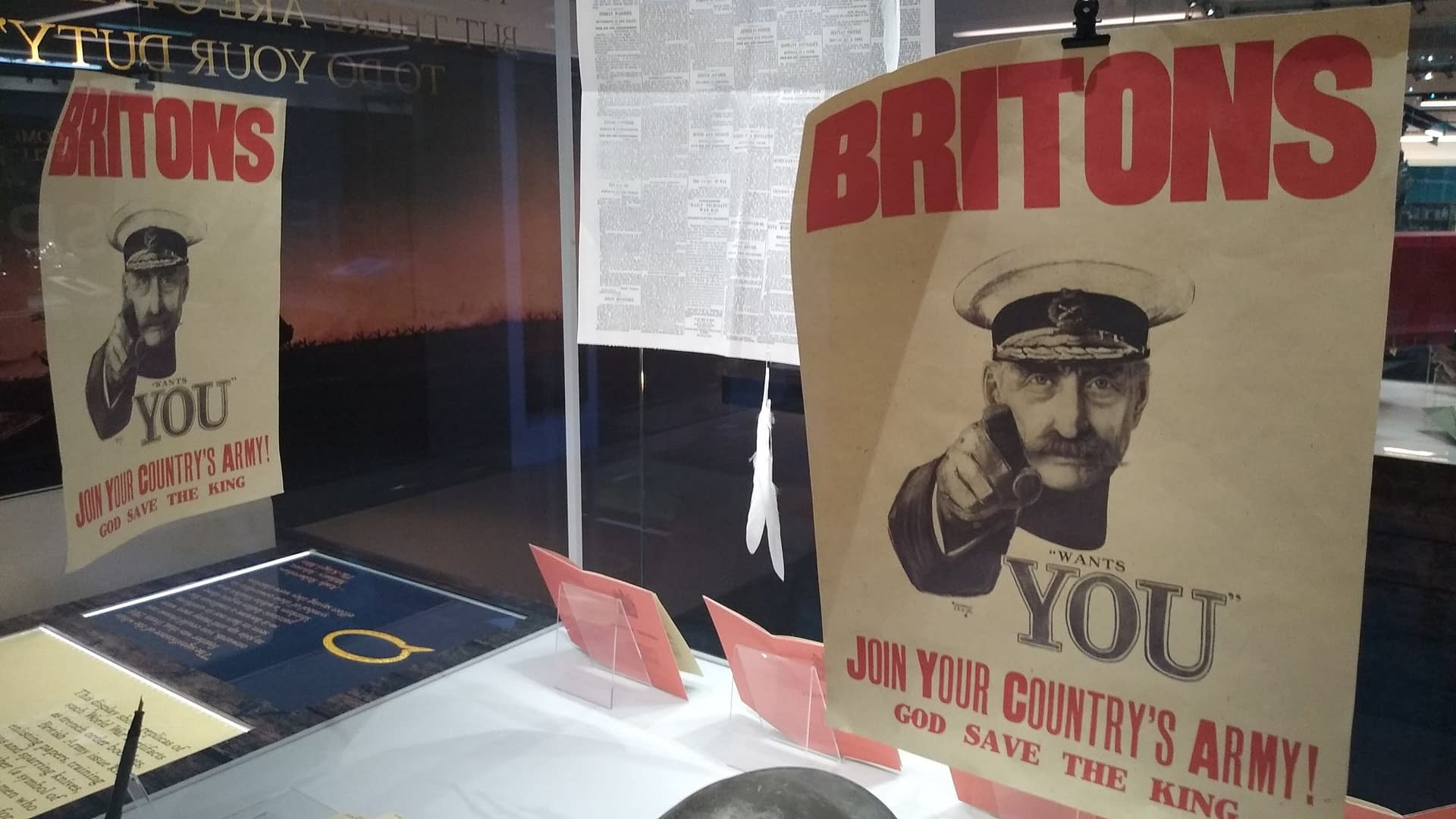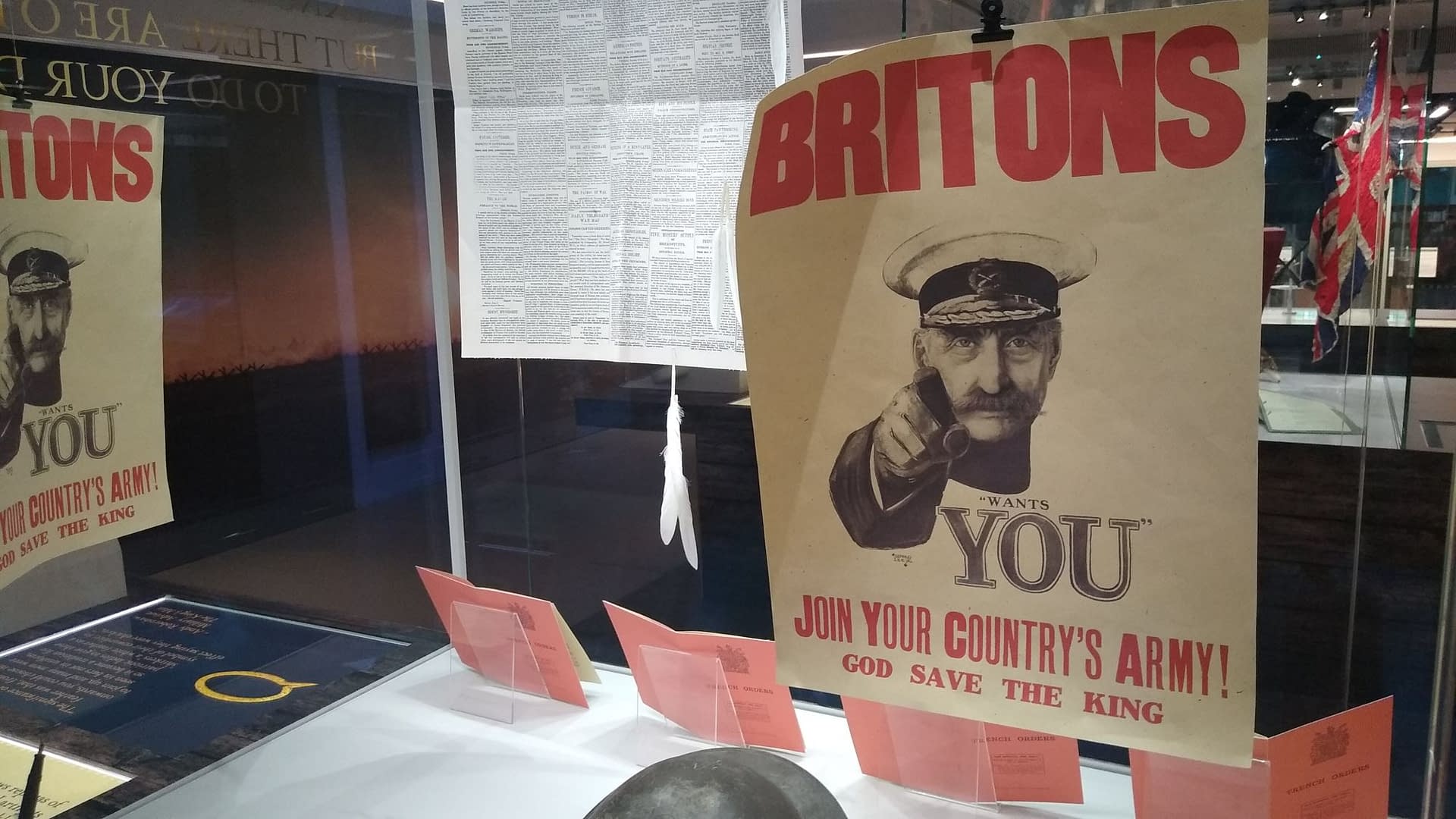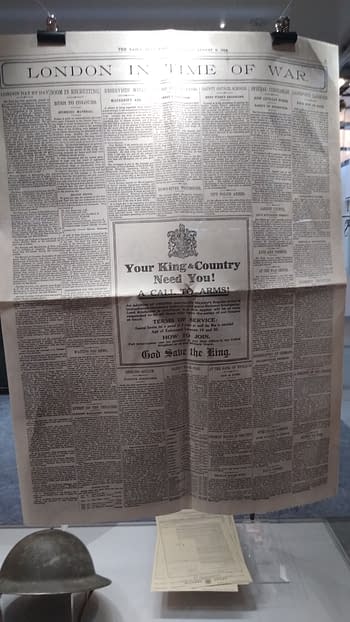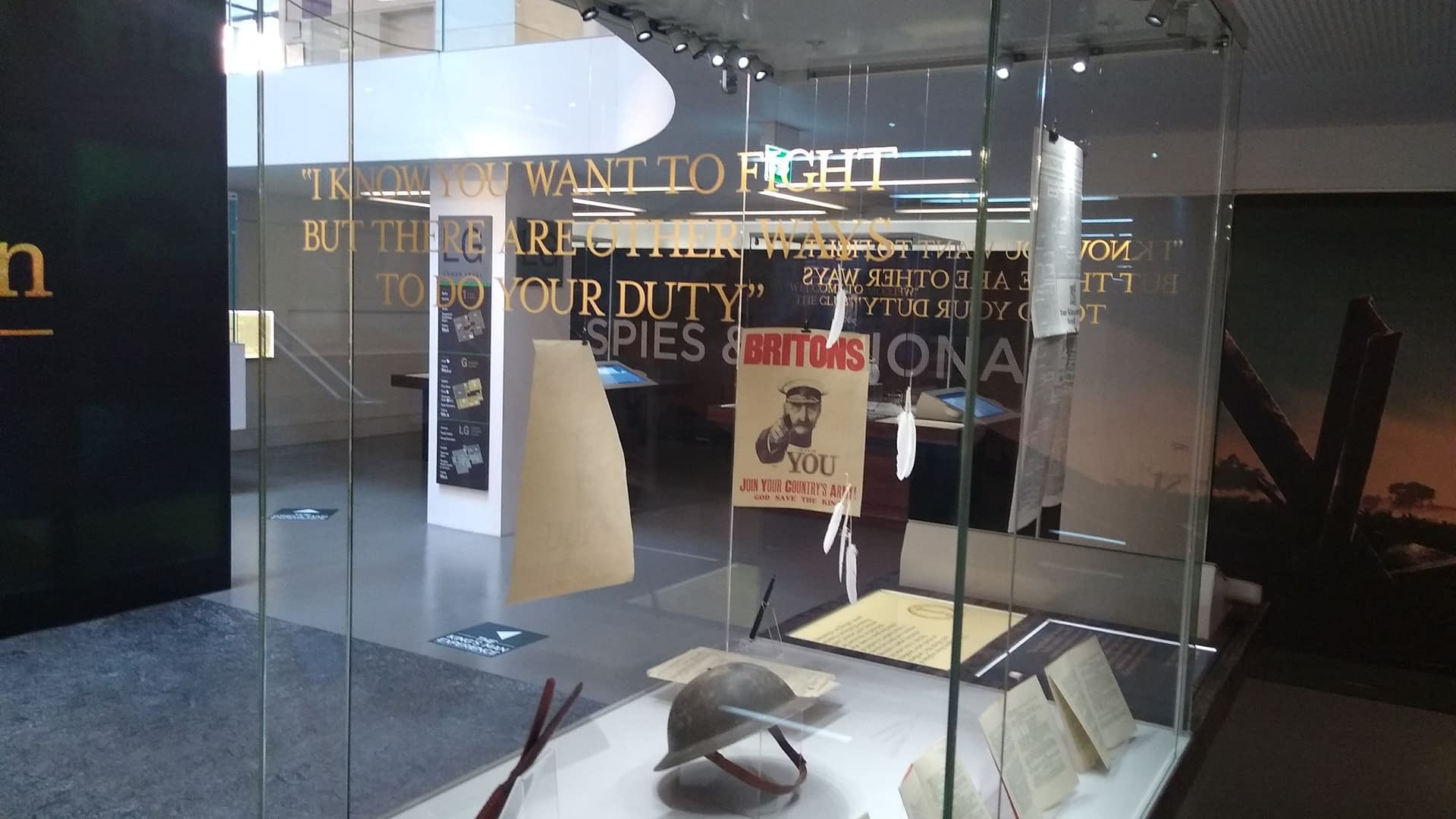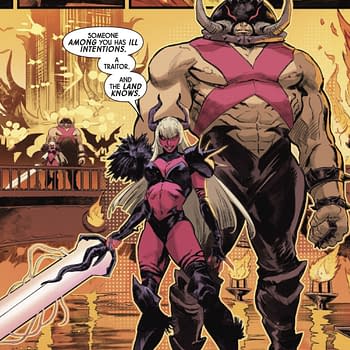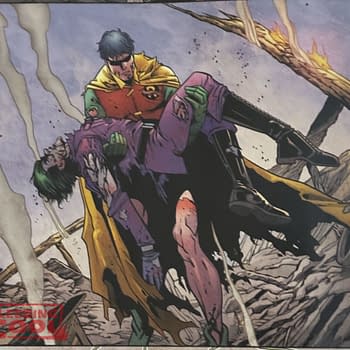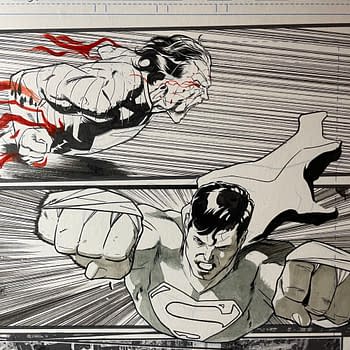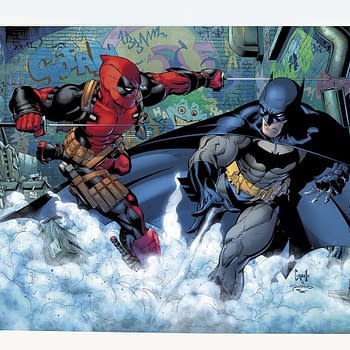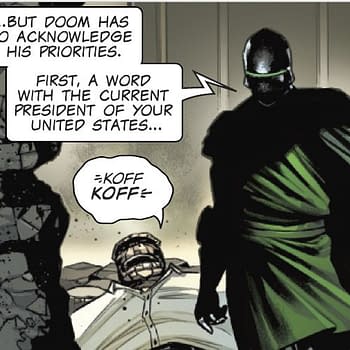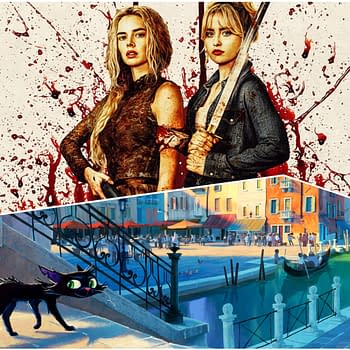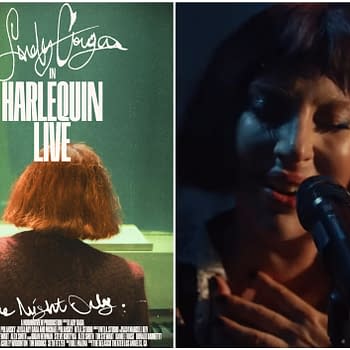Posted in: Movies | Tagged: kingsman, the kings man
Last Year's The King's Man Exhibition At The National Army Museum
One of the very first stories on Bleeding Cool when we launched twelve years ago was the scoop about an upcoming then-unnamed comic by Mark Millar and Dave Gibbons. Now we await the third movie based on those comics, directed by Matthew Vaughn. And what a wait it's been. Last year, when The King's Man was meant to be released after a number of delays, the National Army Museum in London put on an accompanying exhibition. That exhibition doesn't exist anymore, but here's an attempt to preserve it and replicate some of it, ahead of the movie's release later this month.
So imagine it is August 2020 and you are stepping up to the museum… what will greet you as you enter the doors?
Let's take a look at some of the costumes and props on display. Such as for the three characters that Tom Hollander plays in the movie.
Wilhelm II (Tom Hollander)
Of the three imperial cousins (England's George V, Germany's Wilhelm II and Russia's Nicholas la Kaiser Wilhelm was the most prickly and insecure, prone to episodes of bizarre showmanship, such as declaring himself the protector of 300 million Muslims. His attention often wandered, while his immaturity encouraged officials to try and remove him from decision-making. Tending towards paranoia, the Kaiser often imagined himself, and Germany, as the victim of foreign schemes and attacks-
"When Wilhelm was born. the obstetrician damaged his left arm. which was withered. and he always felt he was picked on by his other two cousins. George and Nicholas. In a way. he was the most loyal to Queen Victoria. but felt he could never get the recognition he felt he deserved from his cousins. and used the opportunity to attack the Russian-backed Serbs as a personal vendetta. And as the Russians were in an entente with the French and the British. World War I was effectively a family dispute that got out of hand." – Andy Robertshaw, Military Advisor, The King's Man
George V (Tom Hollander)
The most steadfast of the three imperial cousins (Britain's Cause V Germany's Wilhelm II and Russia's Nicholas 11), George entered the Royal Navy at age 12, an experience that made him a diligent and conscientious adult. His colourful father, Edward VII, held strong I views and sought to influence government policy. By contrast, George lacked his father's biases and was scrupulous in his dealings with ministers. In practice this meant the crown's influence on policy was light, a founding principle of the modern monarchy.
"He was in many ways inspirational to the troops. He went to France on a regular basis. and ensured that both of his sons served. Edward. the Prince of Wales (and future King after George's death. wasn't able to serve on the front, but his other son. the future George VI went to sea. So he put them in harm's way. effectively, and didn't shirk when it came to visiting the front, and being within sound of the guns. So when the troops would say 'God save the King, they meant it: – Andy Robertshaw, Military Advisor, The King's Man.
Nikolai II
The Last Emperor of all Russia, the uncommanding Tsar Nicholas IN fortunes were tied to war. Humiliation by Japan in 1905 briefly limited his power, while World War 1 inspired his downfall. Supposedly a reformer, Nicholas's instincts were autocratic and his intrigues managed to divide and dominate his ministers, at the cost of effective government. 'file influence of the mystic Rasputin over the Tsarina, together with battlefield Ionics, lack of reform, and bungled administration, all led to his execution.
'Real life is stranger than fiction. If you look at historical photos of the Tsar and King George V. they could appear to be identical twins. We didn't change a thing. and so it made perfect sense for Tom Hollander to play all three cousins. We had a lot of fun with the different personalities. known through historical documents. and how to best represent their idiosyncrasies and petty jealousies." – Matthew Vaughan, director of The King's Man.
Rasputin, Rhys Ifans
Grigori Yefimovich Rasputin (1869 – 1916), sometimes known as the 'mad monk' was a Russian mystic and self-proclaimed prophet who wielded considerable influence in the family of Tsar Nicholas II. Born a Siberian peasant, his power increased when the Tsar left the court in St. Petersburg to oversee the Russians fighting on the Eastern Front, leaving his wife, Tsarina Alexandra at the mercy of Raspiutin's considerable charm and charisma.
The King's Man depicts Rasputin (Rhys Ifans) as the power behind the throne of Russia, a puppet-master who can bend the Tsar to his will, riding roughshod over the wishes of the Duma (Russian parliament). After a failed assassination attempt in 1914, Rasputin's power over Russian affairs increases. leading the British government to wonder whether the war effort would be served by Rasputin's death.
"Grigori Rasputin was a larger than life and very real character. advisor to the Tsarina and Tsar Nicholas of Russia. Many historians say he was more a controller than an advisor, which we see in The King's Man. We didn't deviate too far from history; there was great confusion at the time so The King's Man could be closer to reality than anyone knows. Rhys Ifans portrays the self-proclaimed holy man quite incredibly. you have to see it to believe it…" – Matthew Vaughn, director of The King's Man
B.E.2c- Two-seat Biplane
The Royal Aircraft Factory B.E.2c- was a two-seat biplane used by the Royal Flying Corp (RFC) as a reconnaissance aircraft, light bomber and night fighter. First flown in 1912, by 1915 it was outclassed by the new German Fokkers forcing the RFC (which became part of the RAF in 1918) to change tactics and accompany their BE2s with fighter escorts.
In The King's Man, the BE2 is the aircraft of choice for the Duke of Oxford (Ralph Fiennes and later for his protege Conrad (Harris Dickinson). Several aircraft were built for the production, including the one hanging here as the surviving aircraft — now over 100 years old! – were much too precious and dangerous to be used in The King's Man's high-flying action scenes.
There were two biplanes. One was on a sort of pivot on a soundstage. It wasn't a full plane but it was designed to spin, revolve and go upside down. So that was fun and exhilarating. The second biplane seemed to at like a complete plane but it couldn't fly" – Ralph Fiennes, Oxford in The King's Man
"The biplane flight scene was my very first day. I walked into the studio to see a huge BE2 hanging there against a blue backdrop. It was incredible. My legs almost didn't fit in the cabin — it was a squeeze' — then we filmed with it on location too. It was very impressive." – Harris Dickinson, Conrad in The King's Man.
Oxford (Ralph Fiennes)
This display shows the leather flying suit worn by Oxford (Ralph Fiennes) in The King's Man. The open cockpits and exposed engines of the first aircraft used in World War I meant that the wearing of goggles and warm clothing – including the flying helmet, woollen garments and gloves – were essential. Note the blade pushed through the front of the boot – a useful makeshift weapon if you should happen to be shot down over enemy territory.
"When I first went to meet Ralph. I had found a photograph of John Buchan, author of The 39 Steps, that was somehow set yet strong, and that really helped us find the character, We used a lot of photographs and archive footage as reference, but because they're mostly black and white, they don't help you with the colour. Some of the best reference material we used was paintings by artists who were painting around that time." – Michele Clapton, Costume Designer for The King's Men.
Stormtroopers
In 1916 the German army formed assault units of "StoBtruppen", or `stormtroopers: Armed with weapons like grenades and machine guns, they infiltrated enemy positions while their supporting artillery and mortars targeted key points of resistance. In an era of static warfare they could advance at unprecedented rates, gaining five miles in a day at Cambrai in 1917, and spearheading Operation Michael, the German Spring Offensive of March 1918. Stormtroopers wore the iconic M1916 steel helmet, which can be seen in the Museum's Battle Gallery alongside some of the weapons they used. They also experimented with trench armour, or "Grabenpanzer", but this proved too restrictive for assault fighting where speed was of the essence. However, it remained popular with sentries, snipers and machine gunners exposed to enemy fire.
We had lots of photographs of stormtroopers, infiltration fighters who did a lot of hand-to-hand combat. but we also looked at paintings by Otto Dix of some really gothic nightmare stuff of gas masks. and in some ways, they established a mood more than the photographs. so we kept punching it up a level, with these kinds of medieval accessories and the gas masks which look terrifying. The trench armour was to protect you against shell splinters. which very often were done on an ad hoc basis by local blacksmiths.- – Alex Fordham. Military Designer for The King's Man.
"Matthew (Vaughn. the director) showed me references to pieces of armour and kit that seemed from another era. They almost looked medieval and that was a surprise to me." – Ralph Fiennes. who plays Oxford in The King's Man.
Sandhurst
The Royal Military Academy (R M A) Sandhurst, which straddles the counties of Berkshire and Surrey, is the principal training school for officers of the British Army. Formed in 1947 on the site of the former Royal Military College (itself founded in 1801), its distinctive buildings were the original home of the National Army Museum upon its foundation in 1960, before it moved to its current home — where you are standing at this moment.
Like all future officers of the British Army, Conrad receives his training in The Kings Man at Sandhurst, although at the time it was known as the Royal Military College. A number of scenes were filmed on location.
"My favourite scene is Conrad riding up to Sandhurst on his motorbike. There's so much pathos. the colour of his jacket, the red, the dried blood colour, foretelling what's about to happen, and the two little cases on the back of his bike… there's a sort of sadness to it." – Michele Clapton. Costume Designer for The King's Man
Polly (Gemma Arteton)
This display shows the costume worn by Polly (Gemma Arterton). The leather jacket worn in this costume bears some similarities to those worn by the female motorbike dispatch riders during the First World War.
"This dashing action outfit has these great boots, but even when she was dressed in her nanny uniform, she wore these boots underneath. It was as though the boots gave her another dynamic, and Gemma was excited about the fact that the boots gave her this extra attitude. and also gave the actress the sense of who she is."
– Michele Clapton. Costume Designer for The King's Man
Conrad (Harris Dickinson)
This soldier wears the 1913 pattern Officers Service Dress that British Officers would have worn in the trenches. Other Ranks wore a similarly coloured uniform but many of the details were different, allowing officers the distinction of rank and class. Worn with drawers and a flannel shirt, the uniform was uncomfortably hot in summer, while the constricting puttees on the legs contributed to 'trench foot. The famous Brodie helmet which can be seen in the Museum's Army gallery, was hated, but significantly reduced fatal head wounds, while the hobnailed ammunition boots, with steel plates on the toes and heels, were prized booty for German troops,=.
"It was a great honour to wear the uniform of a World War I soldier. Whilst I felt proud and respectable. I also couldn't help but feel I didn't deserve to wear it though it was justified in the context of film making. you can't help but think about the potentially enormous sacrifice that came with the uniform at that time and still today. I knew there were many young boys who lied about their age but to find out that one boy in particular was found out to be just 12 years old whilst serving. was crazy to me. – Harris Dickinson. Conrad in The King's Man.
The display shows a 1902 pattern service dress (or SD) uniform in dark used by some regiments for parades and walking out, worn in The king's Man by Conrad (Harris Dickinson). It comprises a woollen item with a 'stand-and-fall' collar (also known as a 'Prussian collar'). The dress trousers are also dark blue, with a scarlet stripe. His uniform was only worn for parades or when off duty outside barracks, and it went out of use during 1914. In the field, Conrad would have exchanged this dark blue uniform for khaki.
"The first thing to say is how much admiration I have for Michele Clapton (Costume Designer) for the extraordinary detail and diligent design she gave to each outfit. I would also like to pay tribute to John Bright who runs the costume house, Cosprop, his knowledge and experience of period costume and tailoring is unsurpassed. Between the three of us we finessed various different looks including one uniform for Oxford. They felt right because of the consideration of the character – how he would look, what choice of suits he would prefer, the weight of the cloth, the height of the collar – all these elements are discussed in great detail. It is all about character -the character is at the centre of the discussion it feels right because you are trying to create a human being" – Ralph Fiennes
"The younger actors found the high collars really difficult whereas Ralph was very at ease with them. It's my pet hate if they have a gap, but it affects the whole gait and stance of someone. I designed a number of ties that might be the precursor of the ties seen later in the series and get the Kingsman K and the blue/pink/brown colour scheme, and it was fun to design them in the period shape, with the knot quite small. It's a gorgeous silk for tying. because if it's too fat it never keeps its knot." – Michele Clapton, Costume Designer for The King's Man.
Oxford (Ralph Fiennes)
This display shows the dinner suit with the Coldstream Guards regimental insignia wor by the Duke of Oxford (Ralph Fiennes) to attend a grand ball at the Russian Imperial Palace in St Petersburg. It's here in the Palace where the Duke of Oxford and Conrad (Harris Dickinson) meet with Grigori Rasputin (Rhys Ifans).
"I loved doing the Russian ball, because the Russians had strange costumes that were opulent and beautiful with metal headdresses, and we made everything because if you make the costumes you can control the colour palette." – Michele Clapton. Costume Designer for The King's Man.
"The military costumes of the time look stunning to the outside eye. they are quite constricting but also empowering — which I suppose is the point." Ralph Fiennes, who plays Oxford in The King's Man.
(Ralph Fiennes)
This display brings together the casual outfit worn by Oxford (Ralph Fiennes) then he takes his son Conrad (Harris Dickinson) to be fitted for a suit at the famous Kingsman tailor shop on Savile Row.
"With Ralph Fiennes' character, Oxford, we went slightly earlier with his clothes because they were of his time. and to some extent he was living in the past. To look at things emotionally is important, because its not just putting costumes on them. its investing in them as people." – Michele Clapton. Costume Designer for The King's Man.
Conrad (Harris Dickinson)
"When I design for principal characters. I don't design six 'costumes', it's a wardrobe of clothes, so we've always got options. Although, we plot the storyline, on the day we can trv a different tie, and have a dialogue with the actor and a dialogue with Matthew or the actor to put things together in a different way, and then they become clothes rather than a costume." – Michele Clapton. Costume Designer for The King's Man.
"This was an American style, because decided that while Oxford very traditional and a little behind the period, Conrad was quite fashion forward and travelled, so we dressecl him a little racier. Matthewand Harris were reallv nervous about this suit. and it took Harris a while to get used to it, but when we put it on with the hat, he suddenlv felt great in it. You might notice there's broguing on those shoes in the shape of a 'K'. – Michele Clapton. Costume Designer for The King's Man.
The Triumph Model H was a British-made, 499cc motorcycle; selected in 1914 by the war office for its suitability as a replacement for messengers on horseback. More than 30,000 had been built in Coventry by the time the war ended, its reliability earning it the affectionate nickname `The Trusty'.
In The King's Man. the Trusty' Triumph Model H motorcycle is the favoured transportation of Conrad (Harris Dickinson). who is recruited to serve his country in a way he never expected — by joining 'The world's first independent intelligence agency, refined but brutal, civilised but merciless." under the tutelage of the Duke of Oxford (Ralph Fiennes).
"I remember riding up to the Royal Military Academy at Sandhurst on the bike, picking up some speed. wind in my face. then having to stop on a very small mark for the camera. all without looking down. There were hundreds of support-ing artists standing. marching and training as I pulled up and navigated my way through the crowd — it was daunting to sav the least!" – Harris Dickinson. Conrad in The King's Man
We chose the King's Liverpool regiment, or its subsequent incarnations, (because they) refer to the privates as the King's men'. So we thought, if the script doesn't specify a regiment, let's pick that one, which then allowed you to create the details for that particular uniform and the patches for particular theatres of war." – Alex Fordham, Military Designer for The King's Man
This uniform of the Black Watch modifies British battle dress with a cutaway tunic front, for wearing a dark kilt in 'Government tartan'. Phis soldier wears the Balmoral bonnet known as the Tam O Shanter. His 1908 Pattern 'webbing' (the pouches) was issued to regular and territorial army units and differed from the 1914 Pattern leather equipment issued to the volunteer `New Army'. A joke of the era asked `14/hat are soldiers for?' 'To hang things on" came the reply.
This is a Black Watch uniform, with the 1908 Pattern webbing, used to carry ammunition and equipment, and arranged differently for different tasks. In the field, the kilts would have a kind of cotton cover over them, but the director, Matthew Vaughn, wanted to see the tartan so we put the kilt covers on some of the background action, to show that we knew they were worn – Alex Fordham, Military Designer for The King's Man
This display shows props created for the forthcoming feature film The King's Man, including tools used for digging, trenches and building barricades, a German Storm trooper's armoured breast plate, a gas mask, and a bayonet (a kind of knife designed to be fixed to a rifle) and a spiked gauntlet, both of would have been used for close quarters combat in the trenches
All of these props were created for the forthcoming feature film The King's Man. The newspapers hint at some of the real world elements covered in the film, such as the death of General Lord Kitchener and the 'Zimmerman telegram' a coded message intercepted by the British that ultimately helped convince the US congress to authorize America's entry into the war. Note how the face of General Lord Kitchener on the front page of the Daily Sketch has been replaced by the likeness of Charles Dance who plays the Secretary of State for War in The King's Man.
"The significance of the white feather was that, from 1914 onwards, you could choose not to join up, and many men were seen in bars not in uniform, so it became a tradition for patriotic ladies to give these `shirkers' a white feather as a symbol of their cowardice, in effect saying they were chicken"
The King's Man, based on the Secret Service comics by Mark Millar, Matthew Vaughn and Dave Gibbons is released on the 26th of December, 2021.


